-
SNx407 and SNx417 Hex Buffers and Drivers With Open-Collector High-Voltage Outputs
- 1 Features
- 2 Applications
- 3 Description
- 4 Revision History
- 5 Pin Configuration and Functions
- 6 Specifications
- 7 Parameter Measurement Information
- 8 Detailed Description
- 9 Application and Implementation
- 10Power Supply Recommendations
- 11Layout
- 12Device and Documentation Support
- 13Mechanical, Packaging, and Orderable Information
- IMPORTANT NOTICE
Package Options
Refer to the PDF data sheet for device specific package drawings
Mechanical Data (Package|Pins)
- D|14
- N|14
- NS|14
Thermal pad, mechanical data (Package|Pins)
Orderable Information
SNx407 and SNx417 Hex Buffers and Drivers With Open-Collector High-Voltage Outputs
1 Features
- Convert TTL Voltage Levels to MOS Levels
- High Sink-Current Capability Design
- Open-Collector Driver for Indicator Lamps
- Inputs Fully Compatible With Most TTL Circuits
-
On Products Compliant to MIL-PRF-38535,
All Parameters Are Tested Unless Otherwise Noted. On All Other Products, Production Processing Does Not Necessarily Include Testing of All Parameters.
2 Applications
- Audio Docks: Portable
- Blu-ray Disc® Players and Home Theaters
- MP3 Players or Recorders
- Personal Digital Assistants (PDAs)
- Power: Telecom and Server AC or DC Supply: Single Controllers: Analog and Digital
- Solid-State Drive (SSD): Client and Enterprise
- TV: LCD, Digital, and High-Definition (HDTV)
- Tablets: Enterprise
- Video Analytics: Servers
- Wireless Headsets, Keyboards, and Mice
3 Description
These TTL hex buffers and drivers feature high-voltage open-collector outputs for interfacing with high-level circuits (such as MOS) or for driving high-current loads (such as lamps or relays), and also are characterized for use as buffers for driving TTL inputs. The SN5407 and SN7407 devices have minimum breakdown voltages of 30 V, and the SN5417 and SN7417 devices have minimum breakdown voltages of 15 V. The maximum sink current is 30 mA for the SN5407 and SN5417 devices and 40 mA for the SN7407 and SN7417 devices.
These devices perform the Boolean function Y = A in positive logic.
These circuits are completely compatible with most TTL families. Inputs are diode clamped to minimize transmission-line effects, which simplifies design. Typical power dissipation is 145 mW, and average propagation delay time is 14 ns.
Device Information(1)
| PART NUMBER | PACKAGE | BODY SIZE (NOM) |
|---|---|---|
| SNx407J, SNx417J |
CDIP (14) | 19.56 mm × 6.92 mm |
| SN74x7D | SOIC (14) | 8.65 mm × 3.91 mm |
| SN74x7N | PDIP (14) | 19.30 mm × 6.35 mm |
| SNJ5407FK | LCCC (20) | 8.89 mm × 8.89 mm |
| SNJ5407W | CFP (14) | 9.21 mm × 5.97 mm |
- For all available packages, see the orderable addendum at the end of the data sheet.
Logic Diagram, Each Buffer and Driver (Positive Logic)

4 Revision History
Changes from G Revision (May 2004) to H Revision
- Added ESD Ratings table, Feature Description section, Device Functional Modes, Application and Implementation section, Power Supply Recommendations section, Layout section, Device and Documentation Support section, and Mechanical, Packaging, and Orderable Information section.Go
- Deleted Ordering Information table; see POA at the end of the data sheetGo
- Added Military Disclaimer to FeaturesGo
- Changed RθJA values for SN7404: D (SOIC) from 86 to 86.8, N (PDIP) from 80 to 52.1, and NS (SO) from 76 to 85.9Go
5 Pin Configuration and Functions
Pin Functions
| PIN | I/O | DESCRIPTION | ||
|---|---|---|---|---|
| NAME | SOIC, PDIP, CDIP, CFP | LCCC | ||
| 1A | 1 | 2 | I | Input 1 |
| 1Y | 2 | 3 | O | Output 1 |
| 2A | 3 | 4 | I | Input 2 |
| 2Y | 4 | 6 | O | Output 2 |
| 3A | 5 | 8 | I | Input 3 |
| 3Y | 6 | 9 | O | Output 3 |
| 4A | 9 | 13 | I | Input 4 |
| 4Y | 8 | 12 | O | Output 4 |
| 5A | 11 | 16 | I | Input 5 |
| 5Y | 10 | 14 | O | Output 5 |
| 6A | 13 | 19 | I | Input 6 |
| 6Y | 12 | 18 | O | Output 6 |
| GND | 7 | 10 | — | Ground Pin |
| NC | — | 1, 5, 7, 11, 15, 17 | — | No Connect |
| VCC | 14 | 20 | — | Power Pin |
6 Specifications
6.1 Absolute Maximum Ratings
over operating free-air temperature range (unless otherwise noted)(1)| MIN | MAX | UNIT | |||
|---|---|---|---|---|---|
| VCC | Supply voltage | 7 | V | ||
| VI | Input voltage(2) | 5.5 | V | ||
| VO | Output voltage(2)(3) | SN5407, SN7407 | 30 | V | |
| SN5417, SN7417 | 15 | ||||
| TJ | Junction temperature | 150 | ºC | ||
| Tstg | Storage temperature | –65 | 150 | ºC | |
6.2 ESD Ratings
| VALUE | UNIT | |||
|---|---|---|---|---|
| SN7407 AND SN7417 | ||||
| V(ESD) | Electrostatic discharge | Human-body model (HBM), per ANSI/ESDA/JEDEC JS-001(1) | ±2000 | V |
| Charged-device model (CDM), per JEDEC specification JESD22-C101(2) | ±1000 | |||
| SN5407 AND SN5417 | ||||
| V(ESD) | Electrostatic discharge | Human-body model (HBM) | ±2000 | V |
6.3 Recommended Operating Conditions
over operating free-air temperature range (unless otherwise noted)(1)| MIN | NOM | MAX | UNIT | |||
|---|---|---|---|---|---|---|
| VCC | Supply voltage | SN5407, SN5417 | 4.5 | 5 | 5.5 | V |
| SN7407, SN7417 | 4.75 | 5 | 5.25 | |||
| VIH | High-level input voltage | 2 | V | |||
| VIL | Low-level input voltage | 0.8 | V | |||
| VOH | High-level output voltage | SN5407, SN7407 | 30 | V | ||
| SN5417, SN7417 | 15 | |||||
| IOL | Low-level output current | SN5407, SN5417 | 30 | mA | ||
| SN7407, SN7417 | 40 | |||||
| TA | Operating free-air temperature | SN5407, SN5417 | –55 | 125 | °C | |
| SN7407, SN7417 | 0 | 70 | ||||
6.4 Thermal Information
| THERMAL METRIC(1) | SN7407 | SN7417 | UNIT | ||||
|---|---|---|---|---|---|---|---|
| D (SOIC) | N (PDIP) | NS (SO) | D (SOIC) | N (PDIP) | |||
| 14 PINS | 14 PINS | 14 PINS | 14 PINS | 14 PINS | |||
| RθJA | Junction-to-ambient thermal resistance(2) | 86.8 | 52.1 | 85.9 | 88.8 | 52.1 | °C/W |
| RθJC(top) | Junction-to-case (top) thermal resistance | 47.1 | 39.4 | 43.9 | 50.4 | 39.4 | °C/W |
| RθJB | Junction-to-board thermal resistance | 41 | 32 | 44.7 | 43 | 32 | °C/W |
| ψJT | Junction-to-top characterization parameter | 15.6 | 24.2 | 14.6 | 16.5 | 24.2 | °C/W |
| ψJB | Junction-to-board characterization parameter | 40.8 | 31.8 | 44.4 | 42.8 | 31.8 | °C/W |
6.5 Electrical Characteristics
over recommended operating free-air temperature range (unless otherwise noted)(2)(1)| PARAMETER | TEST CONDITIONS | MIN | TYP | MAX | UNIT | ||
|---|---|---|---|---|---|---|---|
| VIK | Input clamp voltage | VCC = MIN, II = –12 mA | –1.5 | V | |||
| VOL | Low-level output voltage | VCC = MIN, VIL = 0.8 V |
IOL = 16 mA | 0.4 | V | ||
| IOL = 30 mA, SN5407, SN5417 | 0.7 | ||||||
| IOL = 40 mA, SN7407, SN7417 | 0.7 | ||||||
| IOH | High-level output current | VCC = MIN, VIH = 2 V |
VOH = 30 V, SN5407, SN7407 | 0.25 | mA | ||
| VOH = 15 V, SN5417, SN7417 | 0.25 | ||||||
| II | Input current | VCC = MAX, VI = 5.5 V | 1 | mA | |||
| IIH | High-level input current | VCC = MAX, VIH = 2.4 V | 40 | µA | |||
| IIL | Low-level input current | VCC = MAX, VIL = 0.4 V | –1.6 | mA | |||
| ICCH | High-level supply current | VCC = MAX | 29 | 41 | mA | ||
| ICCL | Low-level supply current | VCC = MAX | 21 | 30 | mA | ||
6.6 Switching Characteristics
VCC = 5 V, TA = 25°C (see Figure 2)| PARAMETER | FROM (INPUT) | TO (OUTPUT) | TEST CONDITIONS | MIN | TYP | MAX | UNIT |
|---|---|---|---|---|---|---|---|
| tPLH | A | Y | RL = 110 Ω, CL = 15 pF | 6 | 10 | ns | |
| tPHL | 20 | 30 | |||||
| tPLH | A | Y | RL = 150 Ω, CL = 50 pF | 15 | ns | ||
| tPHL | 26 |
6.7 Typical Characteristics
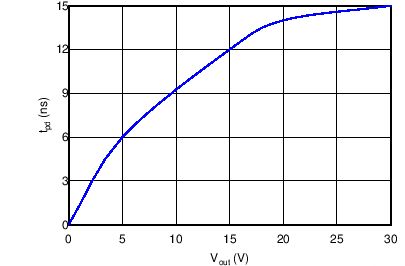 Figure 1. Time Low to High vs VOUT
Figure 1. Time Low to High vs VOUT
7 Parameter Measurement Information
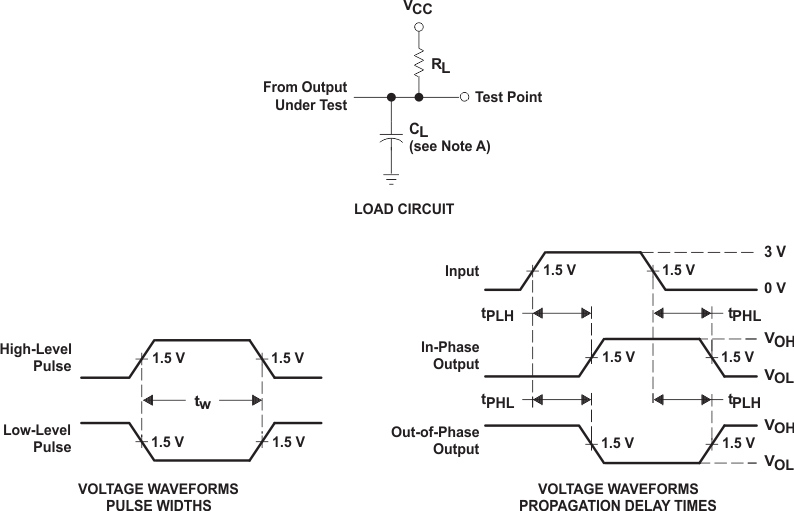
tf ≤ 7 ns.
8 Detailed Description
8.1 Overview
The SN74x7 is a high sink current capable open-collector buffer. This device is high-voltage tolerant on the output of up to 30 V on the SNx407 model and 15 V on the SNx417 model. The SN74x7 is also useful for converting TTL voltage levels to MOS levels.
8.2 Functional Block Diagram
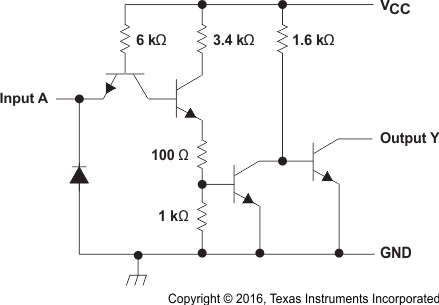
8.3 Feature Description
The SNx407 and SNx417 devices are ideal for high voltage outputs. The SNx407 device has a maximum output voltage 30 V and the SNx417 device has a maximum output voltage 15 V.
The high sink current is up to 40 mA for the SN74x7.
8.4 Device Functional Modes
Table 1 lists the functions of the devices.
9 Application and Implementation
NOTE
Information in the following applications sections is not part of the TI component specification, and TI does not warrant its accuracy or completeness. TI’s customers are responsible for determining suitability of components for their purposes. Customers should validate and test their design implementation to confirm system functionality.
9.1 Application Information
The SN74x7 device is a high-drive, open-collector device that is used for multiple buffer-type functions. The device produces 30 mA of drive current. Therefore, this device is ideal for driving multiple inputs and for high-speed applications up to 100 MHz. The outputs are high voltage tolerant up to 30 V for the SNx407.
9.2 Typical Application
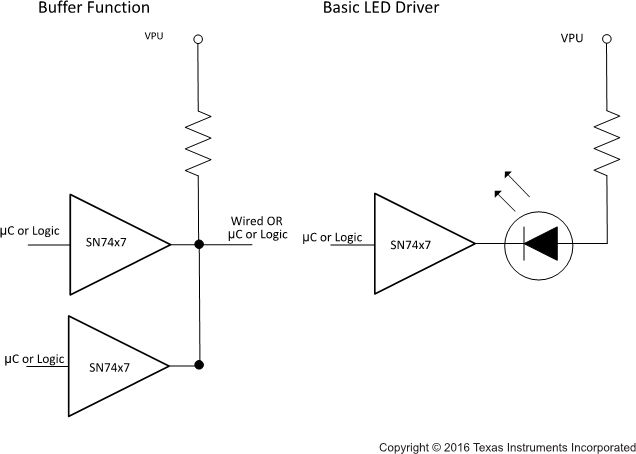 Figure 4. Typical Application Diagram
Figure 4. Typical Application Diagram
9.2.1 Design Requirements
Avoid bus contention because it can drive currents that would exceed maximum limits. The high drive also creates fast edges into light loads; therefore, routing and load conditions must be considered to prevent ringing.
9.2.2 Detailed Design Procedure
- Recommended Input Conditions
- Rise time and fall time specs: See tPHL and tPLH in Switching Characteristics.
- Specified high and low levels: See VIH and VIL in Recommended Operating Conditions.
- Recommend Output Conditions
- Load currents must not exceed 30 mA.
- Outputs must not be pulled above 30 V for the SNx407 device.
9.2.3 Application Curve
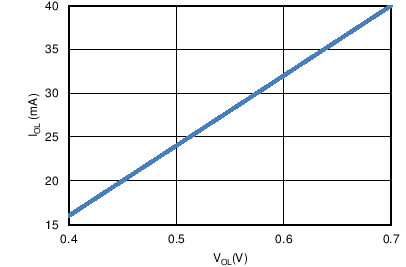 Figure 5. VOL vs IOL
Figure 5. VOL vs IOL
10 Power Supply Recommendations
The power supply can be any voltage between the minimum and maximum supply voltage rating (see Recommended Operating Conditions).
Each VCC pin must have a good bypass capacitor to prevent power disturbance. TI recommends 0.1 µF for devices with a single supply. If there are multiple VCC pins, then TI recommends 0.01 µF or 0.022 µF for each power pin. It is acceptable to parallel multiple bypass capacitors to reject different frequencies of noise. A 0.1 µF and a 1 µF are commonly used in parallel. The bypass capacitor must be installed as close to the power pin as possible for best results.
11 Layout
11.1 Layout Guidelines
When using multiple bit logic devices inputs must never float.
In many cases, functions or parts of functions of digital logic devices are unused, for example, when only two inputs of a triple-input AND gate are used or only 3 of the 4 buffer gates are used. Such input pins must not be left unconnected because the undefined voltages at the outside connections result in undefined operational states. Figure 6 specifies the rules that must be observed under all circumstances. All unused inputs of digital logic devices must be connected to a high or low bias to prevent them from floating. The logic level that must be applied to any particular unused input depends on the function of the device. Generally they are tied to GND or VCC, whichever makes more sense or is more convenient. It is generally acceptable to float outputs, unless the part is a transceiver.
11.2 Layout Example
 Figure 6. Layout Diagram
Figure 6. Layout Diagram
12 Device and Documentation Support
12.1 Documentation Support
12.1.1 Related Documentation
For related documentation see the following:
12.2 Related Links
The table below lists quick access links. Categories include technical documents, support and community resources, tools and software, and quick access to sample or buy.
Table 2. Related Links
| PARTS | PRODUCT FOLDER | SAMPLE & BUY | TECHNICAL DOCUMENTS | TOOLS & SOFTWARE | SUPPORT & COMMUNITY |
|---|---|---|---|---|---|
| SN5407 | Click here | Click here | Click here | Click here | Click here |
| SN5417 | Click here | Click here | Click here | Click here | Click here |
| SN7407 | Click here | Click here | Click here | Click here | Click here |
| SN7417 | Click here | Click here | Click here | Click here | Click here |
12.3 Receiving Notification of Documentation Updates
To receive notification of documentation updates, navigate to the device product folder on ti.com. In the upper right corner, click on Alert meto register and receive a weekly digest of any product information that has changed. For change details, review the revision history included in any revised document.
12.4 Community Resources
The following links connect to TI community resources. Linked contents are provided "AS IS" by the respective contributors. They do not constitute TI specifications and do not necessarily reflect TI's views; see TI's Terms of Use.
-
TI E2E™ Online Community TI's Engineer-to-Engineer (E2E) Community. Created to foster collaboration among engineers. At e2e.ti.com, you can ask questions, share knowledge, explore ideas and help solve problems with fellow engineers.
-
Design Support TI's Design Support Quickly find helpful E2E forums along with design support tools and contact information for technical support.
12.5 Trademarks
E2E is a trademark of Texas Instruments.
Blu-ray Disc is a registered trademark of Blue-ray Disc Association.
All other trademarks are the property of their respective owners.
12.6 Electrostatic Discharge Caution

This integrated circuit can be damaged by ESD. Texas Instruments recommends that all integrated circuits be handled with appropriate precautions. Failure to observe proper handling and installation procedures can cause damage.
ESD damage can range from subtle performance degradation to complete device failure. Precision integrated circuits may be more susceptible to damage because very small parametric changes could cause the device not to meet its published specifications.
12.7 Glossary
SLYZ022 — TI Glossary.
This glossary lists and explains terms, acronyms, and definitions.